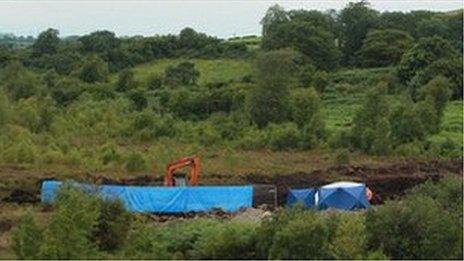Using forensic archaeology to find the Disappeared
- Published

Mr Armstrong's body was found at Inniskeen near where searches were carried out in 2008
Sixteen people were murdered by republican paramilitaries and secretly buried in isolated parts of Ireland during the Troubles.
Nine bodies of the people known as the Disappeared remain unfound but advances in technology alongside traditional methods means fresh hope for their families.
Forensic archaeologists work alongside the Independent Commission for the Location of Victims' Remains (ICLVR) to try and find their bodies.
John McIlwaine, who is originally from Northern Ireland, but works for Bradford University, leads the forensic archaeological team that works with ICLVR.
He outlined the process involved.
"The information first goes to the commission (ICLVR) and they have special investigators who try to prove how accurate it is," he said.
"Once it has been ground proofed through the investigators, we are then in a position to have a search area which we are deployed into, which we search for the remains.
"We have worked on four cases so far and have recovered two bodies.
"Once a potential site has been identified, the archaeological team can begin work.
"We use LIDAR (Light Detection And Ranging) on planes, geographical information, classic archaeology and cadaver dogs."
Many of the bodies have been buried in former cut-away peat bogs, so sites often need to be drained before an excavation can begin.
"It is very difficult because some people were buried over 30 years ago, also the locations were selected specifically for body disposal," Mr McIlwaine said.
"They are remote locations, designed to make it as difficult as possible for anybody to find the body again.
"Then you have the problem that the information is degraded, there is also the fact that there are no obvious grave sites, a lot of them are peat bogs that went out of use years ago.
"The vegetation looks similar, it's covered in heather so there's nothing very obvious, if it was obvious we could just go straight there and dig them up."
In June 2010, Mr McIlwaine led the team which discovered the remains of Charlie Armstrong.
Mr Armstrong, 57, from south Armagh went missing on his way to Mass in 1981, he was believed to have been kidnapped and murdered by the IRA.
His body was buried in an area of peat bog land at Colgagh, County Monaghan, several miles from the border.
In 2008, a team of experts concentrated on an area of bog and gorse at Inniskeen after an anonymous map was sent to the family.
It was the second map the family had received, the first showed a slightly different location.

Mr Armstrong went missing on his way to Mass in 1981
Nothing was found during those searches, but remains were discovered nearby in 2010.
Working within an area the size of three football pitches, the team had to painstakingly draw up the soil, three to four inches at a time, to be sifted through before the next level was taken up, eventually reaching a depth of two metres.
It took about a month, often working in strong winds and torrential rain, to locate Mr Armstrong's body. It then took two months for the DNA to be fully processed.
"It took a great deal of persistence and patience to recover Charlie's remains, but that is the nature of the work we do," Mr McIlwaine said.
"I've got to know Charlie's widow, Kathleen, and their children very well over the years and know how much it means to them to bring Charlie home and give him a proper burial in consecrated ground.
"I feel proud that the team has helped them bring their many years of waiting to an end."
He said finding the Disappeared "was massively important for the friends and family" but "also very important to help the healing process in Northern Ireland".
"We have another site to investigate in the north of Ireland shortly, once the clearance comes through," he added.
"We will continue with the other cases as long as the commission want us to and we have intelligence to work from."